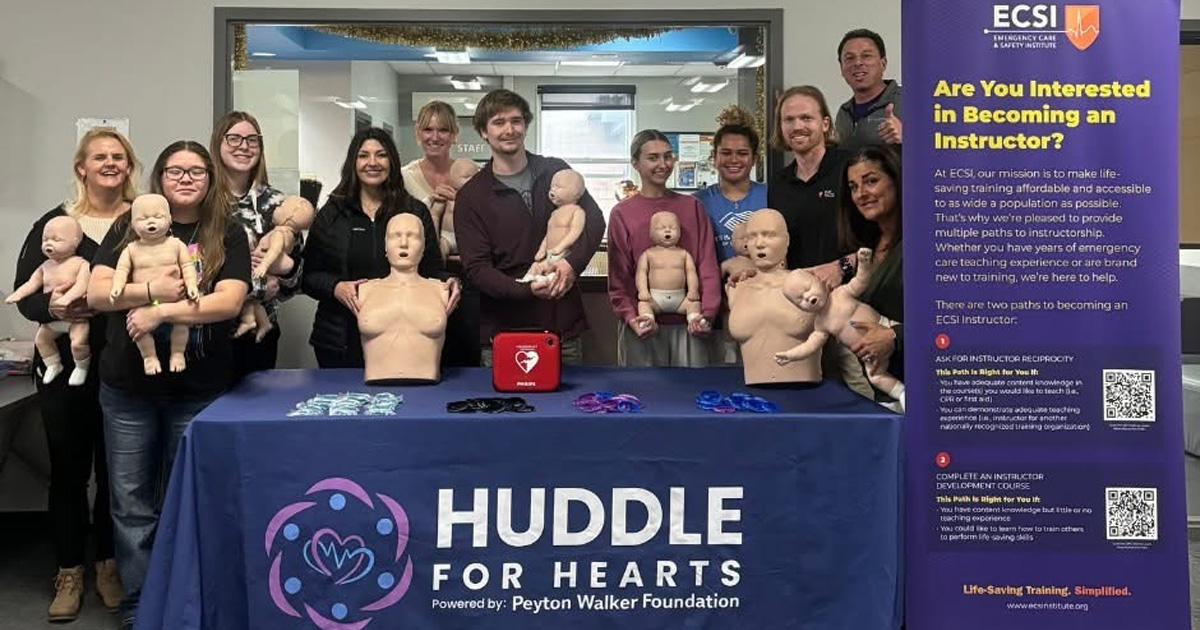20 States, 20 Days: Bringing CPR Training Across America

During a cardiac emergency, every second counts. Understanding CPR and how to use an AED can mean the difference between life and death. However, some statistics suggest only 18% of people are up to date with their CPR training, with even fewer knowing the proper way to use an AED.
The Journey Begins
The 20-day CPR tour was the brainchild of Bill Odoms, a CPR instructor and volunteer with the Peyton Walker Foundation, a nonprofit named in honor of Peyton Walker, who died in 2013 at the age of 19 after suffering from sudden cardiac arrest. Odoms went on his tour through a partnership with Huddle For Hearts®, an initiative created in partnership between The Peyton Walker Foundation and collegiate athletes. AEDs and CPR training are donated to youth sports organizations, with a focus on underserved communities.
After retiring, Odoms thought up a plan to travel the country and bring CPR and AED training on the road. He donated $12,000 to fund his project, kicking off on Veterans Day at Armstrong Indoor Athletics in Kittanning, Pennsylvania. Throughout his journey, Odoms drove 6,352 miles, hosting free two-hour CPR classes in 20 states. He trained 168 people in CPR and AED use and donated a total of 23 AEDs across the states he visited. As part of the CPR Tour, the Emergency Care & Safety Institute or ECSI provided attendees with access codes to free CPR and AED training resources.
Outside of the scheduled two-hours classes, Odoms hosted impromptu CPR demos in the most unexpected of places, including the Arches National Park and at his final stop on the tour: the December 1st football game between the Baltimore Ravens and the Philadelphia Eagles. Odoms turned the tailgate into a classroom, teaching 30 fans how to perform CPR.
Bill Odoms' nationwide CPR and AED training tour had an impact on countless communities, including Sturgis, South Dakota. There, Odoms discovered that the local rural schools were not only without AEDs but were also 30-45 minutes away from any EMS response. Odoms donated four AEDs to the schools in exchange for a promise from the school to perform an annual drill on cardiac emergencies.
While the rural schools contained just a few students, Odoms notes that remote areas are in an even greater need for emergency response infrastructure due to their distance from EMS.
“There’s only a couple of kids there, but that’s even more reason why,” he said. “They’re so isolated.” During the nationwide tour, Odoms took the opportunity to offer hands-on lessons that clarified common misunderstandings about CPR and AEDs. One of these opportunities was in Idaho, where Odoms was able to demonstrate the safety and simplicity of using AEDs - to the surprise of one attendee.
“His big thing was he never saw anyone put an AED on themselves before,” Odoms said. “And how impactful that was to see and allow people to understand that you can’t hurt anyone with that AED.
Improving Access to CPR/AED Training
While the tour was a step in the right direction, it also shed light on the broader need for accessible CPR and AED training.
"We need the federal government, and we need this to be a national thing," Odoms said, calling for a nationwide initiative to promote these critical skills. “CPR shouldn't cost someone $125. There's a lot of us that want to give it away and we'd love to give it away.” He suggested that government funding could cover the costs of instructors and materials, as well as infomercials that educate the public on the importance of CPR.
One area where Odoms notes the results of advocacy is in Maryland. The Joe Sheya Act was passed in 2023, and it requires restaurant and grocery store owners with significant revenue to have AEDs and trained personnel on site. Nationwide, the recently passed HEARTS Act, supported by NFL player Damar Hamlin, will provide grants to elementary and secondary schools to support CPR and AED training. Still, Odoms noted that there is still work to do, including encouraging the public to learn.
“It’s terrible that we have to beg people to learn CPR,” he said. “I really wish there was a better instruction that would be online that people can get.”
In addition to government support, Bill highlighted the role of community involvement. In each class, he encouraged attendees to become instructors themselves, creating a multiplying effect that will only increase the number of lifesavers.
“Everyone needs to be CPR trained,” Odoms said. “If someone's life was saved, there’s no amount of money that could ever replace that.”
Every second counts in an emergency. Find CPR training options near you.